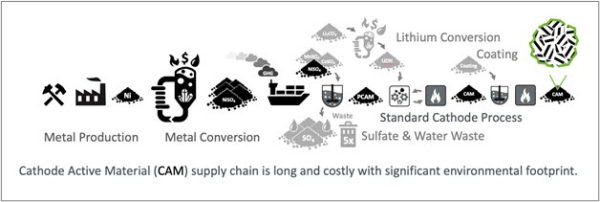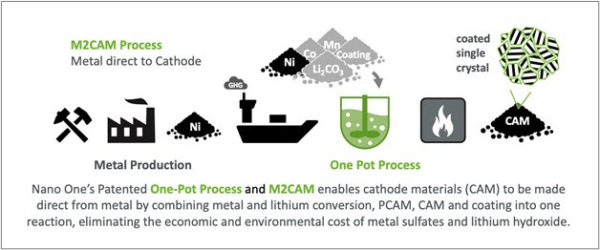Nano One® Materials Corp.(“Nano One”), a technology company with a patented and scalable industrial process for the production of low-cost, high-performance cathode materials used in lithium-ion batteries, has announced its M2CAM (metal to cathode active material) initiative. Nano One’s patented One-Pot process has been successfully adapted for M2CAM, enabling cathode materials to be made direct from metal using nickel, manganese, and cobalt metal powder feedstocks rather than metal sulfates or other salts.
Nano One is actively engaged in a number of discussions with large integrated miners to reduce environmental footprints and maximize upstream value in the global battery supply chain. Nano One’s other collaborators include automotive OEMs with similar motivations to meet environmental targets by reducing waste, carbon emissions, logistics, and costs.
Patents are pending for M2CAM and preliminary test results are showing battery capacity up to 5% higher than cathode materials currently made from metal salts. Nano One CTO Dr. Stephen Campbell will be presenting on Nickel and M2CAM at the BMO 30th Global Metals & Mining Conference on March 1, 2021.
This innovation addresses a growing ESG (environmental social governance) imperative to reduce cost, waste, energy, and carbon footprint in the lithium-ion battery supply chain. Nano One’s innovative one-pot process:
- eliminates the need for costly and energy-intensive conversion of nickel, cobalt, and manganese to sulfate, and lithium carbonate to hydroxide,
- eliminates the shipment of large quantities of water and sulfur, lowering energy, emissions, and costs of shipping by 4-5x,
- eliminates the costly extra step of making precursor cathode active material (PCAM),
- eliminates the economic and environmental cost of handling a waste stream of sulfur and water that is 4-5x larger than the cathode product stream,
- combines feedstock conversion, precursor formation, lithiation, and coating steps using carbon-neutral chemistry in a patented one-pot process, and
- forms durable single crystal cathode powders and protective coatings simultaneously.

Robert Morris, Nano One’s Battery Metals Strategy Advisor and former Executive Vice-President of Sales and Marketing in Base Metals for Vale remarks, “Miners are compelled to reduce their carbon footprint, both from internal corporate ESG mandates and in meeting customer requirements, none more so than those in the battery supply chain. OEMs want ‘clean nickel’ and that refers to the mining, refining, and logistics of getting the product to the place where it will be consumed. Metal producers should have an ESG and premium advantage over sulfate and other non-metal producers if their nickel can be used directly in the production of cathode materials.”

Miners and refiners use a costly and energy-intensive crystallization process to convert nickel, for example, into nickel sulfate (NiSO4.6H2O, 22% nickel, 78% waste) which weighs 4-5x more, before shipping to manufacturers. The metal sulfates are then mixed in a caustic process to form an intermediate precursor while generating 4-5x waste in sulfate and water. Lithium hydroxide (LiOH) is then added to the precursor in a prolonged thermal process to form the cathode powders before the final protective coatings can be applied. This supply chain is long and complicated with energy, carbon emissions, environmental waste, complexity, cost, logistics, shipping, and margins added at each stage.

Nano One’s patented One-Pot process forms durable single crystal cathode powders and protective coatings simultaneously and M2CAM enables these materials to be made directly from metal powders. Metal powders are one-fifth of the weight of metal sulfates, avoiding the added costs, energy, and environmental impact of converting to sulfate and shipping and handling of waste. The One-Pot process is an aqueous process, using carbon-neutral chemistry, that operates at room temperature and atmospheric pressures, and it combines feedstock conversion, precursor formation, lithiation, and coating steps into one reaction. This creates added value for metals and aligns Nano One with the environmental, sustainability, and cost objectives of automotive companies, miners, investment communities, and governmental infrastructure initiatives.











